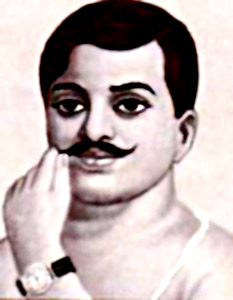 Cabinet Mission which arrived on 24th March 1946 was mainly aimed at devolution of power from the British crown to India giving India independence under Dominion Status in the Commonwealth of Nations. On 28th January 1946, the Viceroy, announced in the legislative Assembly, his intention to establish a new executive council with political leaders and to create a constitution -making body in India. Plans were finalised and devised with the sole enterprise of Clement Attlee, Prime Minister of the United Kingdom. On 19th February 1946, in Parliament, the British Government announced the forwarding of a team of three Cabinet Ministers to India to seek agreement on how to enact self-determination and Independence with the Indian political leaders. The Cabinet Mission included Lord Pethick Lawrence (1871-1961) the Secretary of State for India, Sir Stafford Cripps (1889-1952), President of the Board of Trade and A. V. Alexander (1885-1965), First Lord of the Admiralty. Cabinet Mission also received the boost of Lord Wavell, the Viceroy of India during the time.
Cabinet Mission which arrived on 24th March 1946 was mainly aimed at devolution of power from the British crown to India giving India independence under Dominion Status in the Commonwealth of Nations. On 28th January 1946, the Viceroy, announced in the legislative Assembly, his intention to establish a new executive council with political leaders and to create a constitution -making body in India. Plans were finalised and devised with the sole enterprise of Clement Attlee, Prime Minister of the United Kingdom. On 19th February 1946, in Parliament, the British Government announced the forwarding of a team of three Cabinet Ministers to India to seek agreement on how to enact self-determination and Independence with the Indian political leaders. The Cabinet Mission included Lord Pethick Lawrence (1871-1961) the Secretary of State for India, Sir Stafford Cripps (1889-1952), President of the Board of Trade and A. V. Alexander (1885-1965), First Lord of the Admiralty. Cabinet Mission also received the boost of Lord Wavell, the Viceroy of India during the time.
Meetings held by the Cabinet
On its arrival on 24th march 1946 the mission aimed at having talks with all the major parties of India who had marked themselves on the political canvas of Indian politics. This included parties like Indian National Congress, Muslim League, The Sikhs, scheduled Casts and liberal leader Sir Tej Bahadur Sapru. All the members surrounded around 472 members in total. The cabinet began its discussion on 16th to 18th April when it met Muslim League leader Muhammad Ali Jinnah to outline two plans, comprising a small Pakistan with sovereignty or a big Pakistan in an All-India Union. Jinnah avoided making a choice. Further, in the days of 5th to 12th May 1946, in Shimla, the Cabinet Mission convened a conference, including four members each from the Congress Party and Muslim League. They included for the Congress: Nehru, Chandra Shekhar Azad, Sardar Vallabhbhai Patel and Abdul Ghaffar Khan and for the Muslim League: Jinnah, Liaqat Ali Khan, Ismail Khan and Abdur Rab Nishtar. The Government of India invited
Mahatma Gandhi to come and stand by if needed for consultation. The agenda treated the grouping of provinces, nature of a union and the constitution making process. Cripps` Union of All-India Plan failed to win the acceptance of either the Congress or Muslim League. On May 12th, it became evident that no solution was possible and the Mission announced the failure of the conference.

Proposals made by Cabinet Mission
Cabinet Mission, on its arrival in India, aimed at fulfilling three wide spectrum issues. Firstly, it came to hold a preparatory discussion with the elected members of British India and the Indian states in ordered to secure maximum agreement over the issue of framing a new constitution; secondly, to set up a constitution -making body; and thirdly, to establish a full self-government in India. Along with this regarding the minorities it claimed that they had full knowledge of the minorities but could not allow the minorities to place veto on the advance of majority party.
The cabinet then sought to answer some of the vital questions which were engulfing Indian politics for long. On the issue of accepting an independent Pakistan, the Cabinet Mission completely rejected the idea on communal grounds and claimed that it would not solve the problem. As the committee estimated that the Hindu and Muslim population on the western zone were at a ratio of 62:38 and on the eastern zone it was 51.7:48.3. On the basis of these calculations the Cabinet came to a conclusion that a separate state of Pakistan was not viable. Secondly, the mission also raised question regarding the level of communication to be established with the new state falling under Pakistan .Even in case of distribution of Army also it will turn out to be a trouble. On a positive side the mission suggested creation of a federal Union consisting of British India and Indian states. The union will deal with the foreign affairs, defence and communication and authority to raise finances for these subjects
Reaction of the All India Parties to Cabinet Mission
The Cabinet Mission was received with a multiple reaction. As the Mission announced on16th May its three tier scheme for forming a Union of All-India consisting of Hindu-majority provinces, Muslim majority Provinces and the Indian States. On 25th June, the Congress Working Committee passed a resolution to accept the Cabinet Mission`s plan and to enter the Constituency Assembly. The Sikhs on other side were in favour of a united India. The scheduled castes were against the partition and wanted to guarantees of their human rights. The Hindu Mahasabha insisted on the favour of immediate transfer of power and indivisible India.
Thus, the Cabinet Mission can be regarded as the most effective step adopted by the British government to reach India towards Independence .The mission for the first time made a public declaration of its intension to grant India free from subjugation. Though this mission only talked of an interim government with a dominion status it was later on condemned for this .Nevertheless it paved the way for the Indian leaders to experience the running of a nation as a whole.



















